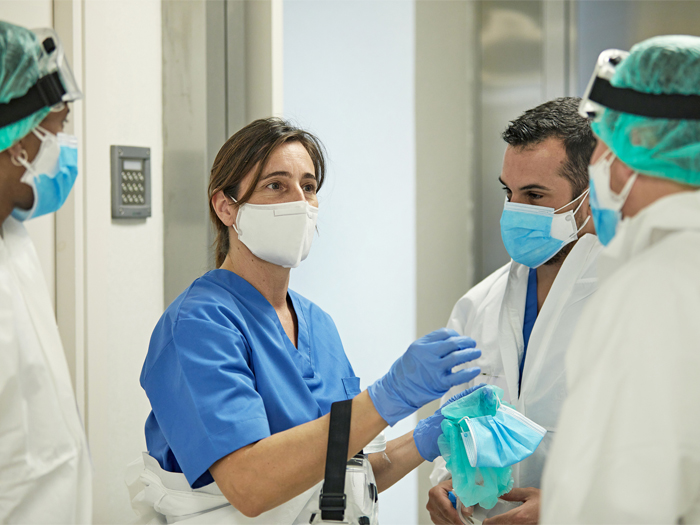Sponsored Content by MedRisk
How Physical Therapy Breaks Down Psychosocial Barriers to Recovery

While the term biopsychosocial has been part of the workers’ comp lexicon for more than a decade, industry shifts in recent years have pushed it closer to the forefront. With all the changes wrought by the pandemic’s impact on businesses and on the workforce, that focus is now aligning with patient care in a unique way.
Biopsychosocial, put simply, refers to the union of the biological, psychological and social factors that can impact an individual’s health, including their ability to recover from an injury.
It’s become increasingly well understood that a broad range of factors within these three spheres can impact a workers’ recovery. A worker could be experiencing stress and worry over feeding her family or paying the bills. Or they might have mixed feelings about returning to work because of fear of reinjury or concerns about conflicts with their supervisor that were bubbling even before the injury. Maybe the worker suffers from a comorbid condition that hasn’t been treated for a variety of reasons.
Unlike bruises or lacerations, psychosocial setbacks tend to be invisible. And they’re likely to stay that way unless someone asks questions and makes observations that haven’t typically been a part of the intake process on an average claim.
Claims organizations are paying attention, and have been working to adapt, to build processes and tools that help identify these elusive red flags. The earlier that risks or obstacles are identified and addressed, the better the potential outcome for the worker, the employer and every stakeholder on the claim.
“The research is out there now that this makes a difference in recovery,” said Brian Peers, VP of Clinical Services & Provider Management, MedRisk.
“When these issues are identified early and managed early and resources are allocated to them, people are recovering faster and they’re more satisfied with their care. So getting that type of information in the hands of the individual providers and the individual adjusters, that makes a world of difference, but it takes time.”
Time, however, is often the enemy of positive outcomes. Sometimes it’s not until a claim has already begun to slip off the rails that the search for red flags even kicks in. Proactive employers are seeking out new tools and solutions to gain these strategic early insights.
But what about finding new ways to leverage the tools and resources we already have?
One-on-One Engagement Is Key

Brian Peers, VP of Clinical Services & Provider Management, MedRisk
In the case of musculoskeletal injuries in particular, that means taking a fresh look at physical therapy, and the role therapists play in the care of injured workers – not just treating their physical injuries but identifying any additional biopsychosocial issues that could impact recovery.
Making the connection between recovery through physical therapy and psychosocial barriers may seem like a logical leap, but it’s worth exploring. A therapist might spend up to 15 hours a month with an injured worker – far more time than a treating physician or a claims adjuster or anyone else.
“Physicians do not get to spend enough time with the injured workers or patients in general, as they’re under time constraints due to financial pressure to see more patients daily,” said Jean Feldman, RN, BSN, Director of Managed Care, Workers’ Compensation Claims for Sentry Insurance.
“They may be lucky if they have 10 or 15 minutes.”
“So it’s a chance for a very intimate connection with a health professional, someone whose radar is up to not only look for these issues, but to help manage them,” said Peers.
“It’s another set of eyes,” added Feldman. “It’s another clinical person involved with the injured worker that can help answer questions about the treatment plan, but also be a great listener to hear what that injured worker is bringing to the table as they start down that path.”
Therapists have the opportunity to build trust and engage in meaningful conversations about how the injured worker is doing, not just as a patient, but as a person. What challenges are they facing, how are they coping?
Bridging A Gap in The Mind-Body Connection

Jean Feldman, RN, BSN, Director of Managed Care, Workers’ Compensation Claims, Sentry Insurance
“The therapist’s responsibility is to expedite recovery,” said Peers, “to restore function and get the injured worker back to their pre-injury function. One of the things that slows that process down is some type of barrier. That could be logistical, the person can’t get to therapy, but it also could be psychosocial, like a mental health issue, but there’s a lot of factors that could be at play there.
“What we’re advocating for is this idea of let’s be open to finding them, let’s look for them early, and then let’s try and manage them along the way,” he said.
One way that therapists can help directly is by addressing injury-related psychological factors like catastrophic thinking or fear avoidance behaviors, using education and coaching to help the worker move past those feelings.
Explained Peers: “If someone’s feeling like, ‘I don’t want to move because I think it’s going to hurt,’ who better to help them through that than someone who’s an expert in recovery? So not a psychologist, not an orthopedic surgeon, but someone whose specialty is recovery.
“This mind and body connection is a big part of not just physical therapy practice, but also physical therapy education. It’s now starting to get baked into the profession in a way that’s helping rehab professionals to understand how to help manage these patients through this process.”
Through interaction and observation, the therapist can also be on the lookout for other issues that commonly accompany injuries, such as anxiety or depression. Throughout each interaction, therapists can check the radar for any social or socioeconomic factors that might be creating barriers or causing additional stress for the injured worker, like transportation issues, the lack of a support system or a heavy load of caregiving responsibilities.
“Therapists can’t do it all alone,” said Peers. “But they can be looking for these issues, raising the flag, notifying everybody that’s involved that there might be an issue here to manage. So many of these things that can really delay recovery are easy enough to manage when you have that much one-on-one time with the health professional.”
Maybe that means the person doesn’t seem motivated to engage in therapy. Maybe they’ve been delaying a knee replacement, which will hamper the effectiveness of treatment for a back injury. Maybe they’re caring for a sick child or spouse and can’t fully focus on their own recovery.
“These are things that are outside the control of the consulting therapists, but need to be illuminated and then put in the hands of another professional who can help to manage that,” said Peers.
“By screening for factors that could slow things down, lining up resources to try and manage any of these barriers that come up, and then making sure that the injured worker is in the right headspace to get started, it’s the hallmark of this approach. That therapist is positioned to monitor them in a new way based on this insight as they move through that process.”
Feldman firmly agrees. “It’s about looking at the person as a whole,” she said. “Your brain can drive a lot of how you’re responding to physical therapy, and the fear that happens when somebody first has an accident. [We need to] understand how pain can be magnified by where that person is at in their life because of outside factors and because of what has happened in their life prior to the point of injury.”
Compassionate Coaching to Overcome Overwhelm
Boiled down to its essence, biopsychosocial treatment awareness is about compassion for injured workers’ and their circumstances. When it comes to musculoskeletal injuries, this is an area where even caring employers often need more support.
It’s easy to express compassion for injured employees in the face of a catastrophic injury. But that is often overlooked in the case of more commonplace injuries like a lumbar strain or rotator cuff tear.
“One of the key things I see is that what really can break, especially early in a claim, is that relationship the injured worker has with their employer,” said Feldman. And whether we’re talking about a spinal surgery or finger fracture, that employer relationship can play a significant part in ensuring a swift and smooth recovery.
“We have to educate that person so that they’re not overwhelmed and walk them through the process. That may mean more frequent interactions with the individual and coaching that employer to keep those lines of communication open,” she said. “We can prevent a lot of litigation if we are really looking at the person as a whole, and if we’re good listeners and effective communicators.”
“There’s a huge opportunity for the employer to play a bigger role, making sure that they’re doing the right things and have open communication with that injured worker as they’re going through the process of healing.”
That collaborative communication is essential for all stakeholders to understand the role they play in driving the best possible outcomes for every claim, said Peers.
“It’s important that everybody understands what therapy looks like, what should be happening, what the individual injured worker’s responsibilities are in their recovery, what the therapist’s responsibilities are, what the physician’s responsibilities are, etc.”
‘Doing the Right Thing’ To Influence Your Claim Outcomes
Doing the right thing is paramount. But we also need to be able to quantify what makes it right. Is it shortening the amount of time that someone is in therapy? Is it shortening the amount of time that it takes to return to work? Is it lowering the overall claim costs? Is it reducing the risk of litigation? Are patients less likely to receive an opioid prescription? The answer to all of these questions, say Peers and Feldman, is yes.
We advise to “take a closer look at your physical medicine program, are your vendor partners leveraging the therapists’ to address both patients’ mental and physical needs?” asks Peers. “If you are looking for the biggest potential impact, consider a solution that offers some degree of insight into each claim and various aspects of that claim.”
“This is where we work closely with MedRisk,” said Feldman.
“In order to establish how you truly are impacting claims, you’ve got to look at your pharmacy data, indemnity spend, medical spend, you really have to bring everything together. So while it’s great and we’ve seen it has reduced physical therapy visits, what else is it doing? It’s really a collaborative effort, [bringing the data] together to look at things holistically to ensure that the program is moving in the right direction and bringing you the results.”
“If we do the right things, she said, “it will help that individual get back to work, recover faster, recover safely. It’ll help our employers decrease their costs. We’re all in this together.”
To learn more, visit: medrisknet.com
To learn more, visit: sentry.com
This article was produced by the R&I Brand Studio, a unit of the advertising department of Risk & Insurance, in collaboration with MedRisk. The editorial staff of Risk & Insurance had no role in its preparation.










